
| home | catalogue | history | references | appendix |
 |
surfresearch.com.au
the
catalogue : prone and knee boards
|
| surfboards | paipos* | fins | board portraits |
It does not
appear to be a traditional Hawaiian surboard term and
critically, it is not included in the Appendix of Hawaiian
Surfing Terms of Dr. Ben Finney's groundbreaking The
Ancient Sport of
Surfing (1966, pages 94-96 in the 1996 edition).
Nor is paipo
mentioned in the body of the text, with the term bodyboard
preferred.
In
addition, there is no entry for the word in:
Pukui, Mary
Kawena and Elbert, Samuel H.: Hawaiian Dictionary:
Hawaiian-English, English-Hawaiian.
Revised and
Enlarged Edition.
University of
Hawaii Press, Honolulu, 1986.
Paipo
appears in print in a number of surfing books published
in 1965 by Farrelly, Dixon, Severson, Klein and John Kelly's
excellent Surf and
Sea (1965).
He glossary
entry for paipo, includes a possible
derivation for the term and indicates it "is from
popular usage":
There is no
entry for bellyboard.
"paipo:
A small surfboard from approximately one to three feet long
held in front with the hands or beneath the chest; a belly
board.
Some riders
can stand on paipo boards.
The term is
from popular usage but may stem from pae, to ride a
wave to shore, and pu, the sea at midtide
(Hawaiian)."
Kelly: Surf and Sea (1965)
page 290.
Kelly's claim that "Some riders can stand on paipo boards" is confrirmed by a photograph by Val Valentine, facing page 192.
Puki's Hawaiian Dictionary (1986) confirms Kelly's interpretation of pae and pu:
pae.
2. vi. To
land, disembark, come ashore; to mount or catch a wave, as
of a surf rider; washed or drifted ashore.
... Pae
i ka nalu, to ride a wave into the shore." (page 298).
pu.
11.
... Kai pu, a sea without animation, sea at
midtide."
also
6. n. canoe
end-piece, both for and aft." (page 344).
It is
difficult to see how this transcription of pu as "the
sea at midtide" is an applicable to a prone board.
Perhaps the
sixth definition, the fore or end piece of a canoe, is more
relevant.
The earliest
European report of surf riding by Banks (1769) is on "the
stern of an old canoe."
In the Ellice
Islands, there are two methods of te seke (surf
riding) - faka-tua-fonu (body surfing) or using the puke.
The puke
is the, often used, bow-covering of a canoe, and the same name
is applied to any board so used for surf riding.
- Kennedy, Donald Gilbert: Field Notes on the
Culture of Vaitupu, Ellice Islands.
The Journal of Polynesian Society
, Volume 39 Number 1, No. 153, March 1930, page 111.
In a report of surfboard riding in Somoa in 1866, W. T. Pritchard noted that, alternatively. they would "take to their paopao, or little canoes, and pass the rest of the morning in them at the same sport."
- Pritchard, W. T.: Polynesian Reminiscences, Chapman and Hall, London, 1866, page 186.
Note also that
the entry for pu has an alternate derivation, that
may be applicable to the dished nose design:
Similarly, but
far less likely, the term "pa ipu" (the a has an
overmark) meaning "Calabash, wooden dish in general
cooking utensil, bowl" [Puki: Hawaiian
Dictionary (1986) page 303], also could have been
adpted to describe the dished nose design.
Kelly makes special mention of the wide-tailed dished nose design, however he identifies it as a "Skim or skitter board".
| This is not to be confused with the
1960s Skimboard, a flat plywood, often
circular, board that is not (normally) a wave riding
craft. The rider would carry the board and run at full speed before lauching the it in the shallows and jumping onboard for a fast but brief ride. See #237, image right. |
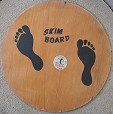 |
"A fast finless belly or paipo board about board 42 inches long and 30 inches wide and around three-eighths of an inch thick with a flat bottom-one of the fastest wave-riding devices."
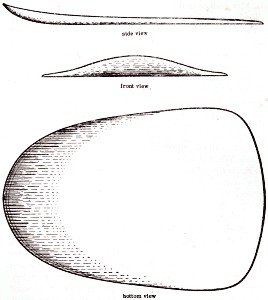 |
Approximate dimensions: length 42", width 30'" thickness 3/8", bow scoop 3". Kelly:
Surf and
Sea (1965) |
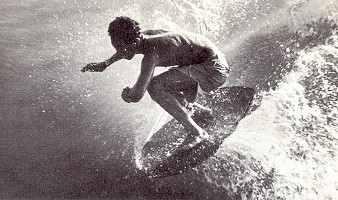 |
in standing crouch on the zippy skim or belly board at Kuhio pier, Waikiki. Photo by Val Valentine." Kelly:
Surf and
Sea (1965), |
| At this
point (June 2009), one early commercial use of the term
is a decal for a prone timber board, possibly produced
between 1935 and 1955. The decal reads: Hawaiian PAI PO BOARD Mgf. By FROISETH. The image was listed at stanleys surfcrazy logo library and is reproduced with permission, right. |
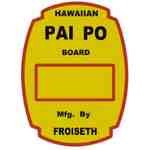 |
Froiseth was
probably Wally Froiseth, born in Los Angles in 1919 and who
moved to Honolulu in 1925.
He began
surfing at age eight and was active as a surfer, contest
director and judge until the1970s- a forty year surfing
career.
The brief
biographical notes (see Appendix C,
below) are mainly based on Wally Froiseth's entry in Matt
Warshaw's essential Surfing Encyclopedia and, needless
to say, there is no mention of the decal or board under
discussion.
With such an
extensive resume and out specific contemporary
documentation or first person annecdotes, it is impossible to
suggest a date for the Froiseth decal.
It could easily
be anywhere between 1937 and 1970.
At a guess 1956
(???).
Note that John
Kelly (quoted above) and Wally Froiseth were close surfing
compatriots.
In 1936-1937,
Froiseth, Kelly and Fran Heath developed the tapered-tailed Hot
Curl design, setting the precedent for the templates of
Gun or Speed boards for the next 50 years.
See Source
Documents George Obelian : Give
It
the Axe- Early Development of the Modern Gun
Ancients -
Hot Curls - Simmons - Downing., from...
Surfer
Magazine Vol 30 No. 10 1989, pages 104 - 105.
In the early 1960s, Val Valentine was observed building the dished-nose Paipo boards in Hawaii:
" I watched
Val Valentine as he made a Paipo for me in Hawaii, and could
see that there would be a better way of doing it.
He used a
moulding surface to shape the bottom of the board.
This was
formed in earth outside his house, and lined with cement
mortar.
He
laid vaneers (sic) of timber in this with glue
between, then pressed the whole thing with sandbags on top.
When the
glue had set, he trimmed and finished the board.
Concave tails
to boards were all the rage that season, and Val was
spending much of his time trying to build a concave Paipo
that would work.
I could see that this was not
working out at all, and returned to Australia with one of
his regular (non concave) Paipo boards.
-emailed by Jamie Farfor
16 February 2005.
Jamie Farfor returned to Australia and began
manufacturing his own model:
"... I built a press that had a
concrete base mould at table height, and was loaded with a
hydraulic powered airbag.
This makeshift thing ran off
mains water pressure and put over 20 ton pressure on the
boards while the
glue set.
Looking back on it, I was lucky
that the thing never exploded.
I
started using timber vaneer, but was unable to get suitable
quality of material.
I then
tried using layers of eighth inch thick hoop pine plywood,
and found that with the extreme pressure
that I
could form the two way curve (shallow dome) at the nose of
the board.
By
putting plastic sheet between, I was able to form 3 boards
in the press at a time.
With the stresses in the plywood, the curvature at the nose was less than with the timber vaneer."
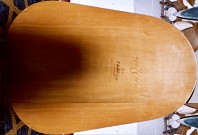
|
Paipo board by Jamie Farfor. Deck and bottom. 3ft 5'' x 29 1/2". Varnished plywood with branded decal and fabric laminated bottom. Right:
Dimensions
and photographs |
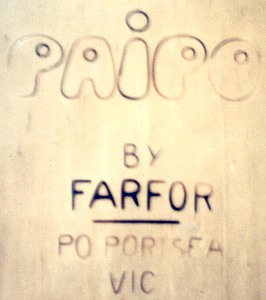 |
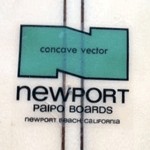 Newport Paipo Boards Newport Beach |
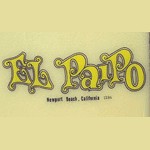 El Paipo Newport Beach. |
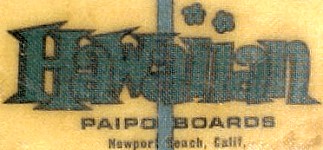 Hawaiian Paipo Boards Newport Beach |
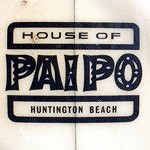 House of Paipo Huntington Beach |
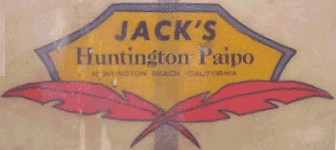 Jack's Huntington Paipo Huntington Beach |
The skim board is very simple in design having a perfectly flat planing surface with sharp breakaway trailing edges. It has no skeg. The size of the skim board is important in relation to the weight of the rider that its lift surface must support. Average dimensions are approximately 3 1/2 to 4 feet in length. The aft end is usually less than 3 feet wide, and it tapers somewhat to a narrower front end which is cambered to prevent digging. Most of them are made of 3/8 inch plywood, surfaced with the usual fiber-glass and resin. The curved front edge may have an elevated rim for gripping.
The riding
technique consist of railing the extended aft side-edge of
the skim board into the wall for the beginning of the fast
slide.
This enables ascent to a high position for the drop. On the
drop, the board'is levelled with the water and tucked
beneath the rider's chest, his head and shoulders extending
over the front end and legs over the back end but not
touching the water. The arm on the side of the slide (left
arm on a left slide) extends forward to get it out of the
way of any water coming over the side. The board then
assumes a highly efficient planing position and achieves
great speed.
On large
waves, say twelve to fifteen feet or more, the skim board
riders skid down the slopes hitting only the high spots,
board and rider being airborne for a good part of the time.
Without a skeg and drag produced by side pressure thereon,
the skim board follows more closely the path of its own
inertial flight and thus achieves the highest speed thus far
of any wave-riding device."
APPENDIX C.
Wally
Froiseth
In 1936-1937,
Froiseth with John Kelly and Fran Heath, developed the
tapered-tailed Hot Curl design, setting the precedent
for the templates of Gun or Speed boards for
the next 50 years.
See Source
Documents George Obelian : Give
It
the Axe- Early Development of the Modern Gun
Ancients -
Hot Curls - Simmons - Downing., from...
Surfer Vol
30 No. 10 1989, pages 104 - 105.
The ultimate
testing ground for the Hot Curls was Makhaka Beach, although
the crew did make some attempts at riding the powerful breaks
of the North Shore.
Froiseth and
his step-son, George Downing, were the first to ride Lankiakea
(1946) and Maui's Honolula Bay (1947), before testing the Hot
Curl's in Southern California during 1948 .
He won the
prestigious Makaha contest in 1959 (aged 39) and next year
became the contest director until it ceased in 1971.
He was a
respected and valued judge at wide range of surfing contests.
"...Froiseth
built, sailed, and paddled all manner of canoes and
catamarans."
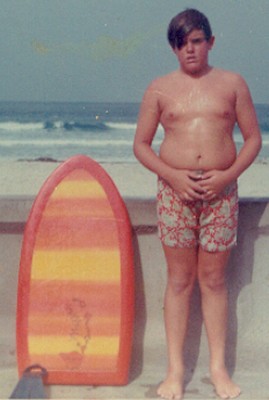 |
In November 2019, Bill Yoggerst
contributed the photograph and
noted: My First Fiberglass Bellyboard Purchased new at Hamel's Surfboards (Surf Shop), 704 Garnet Ave, San Diego, CA, USA in August, 1968. Manufacture: U/K - Hawaiian? (Someone will likely recognize the logo). In response to an email, Rod noted that it: looks like one of the Al Hertz mass produced series of bellyboard/paipo boards. Attached is an advert from Surfer, April-May,1968, Volume 9 Number 2, page115 . Subsequently, Rod mailed two other Al Hertz advertisements: Surfer June-July, 1968, Volume 9 Number 3 page 44. Surfer August-September,1968, Volume 9 Number 4 page 99. This ad also featured three custom paipo boards, see below. Many thanks to Rod at My Paipo Boards and ...More Hawaiian (Paipo)
decal courtesy of Stanley's Logo Library
http://www.surfcrazy.com/stanleys/html/surflogoh.html |
|
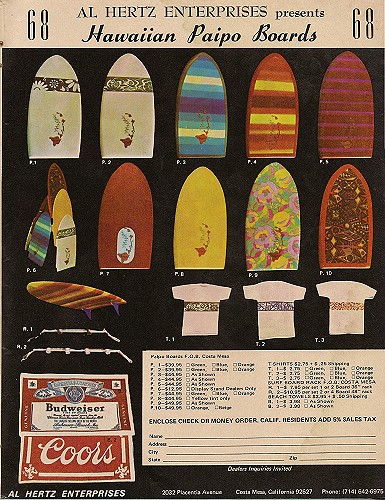 |
Surfer April-May,1968, Volume 9 Number 2, page115. Al Hertz
Enterprises: Hawaiian Paipo Boards,
1968.
Hawaiian Paipo
Boards: P1 - P2 $39.95 P3 - P6 and P7 - P10 $44.95 P6 (Display stand, Dealers only) $12.95 Tee Shirts: $2.75 plus $2.25 shipping Surfboard Racks: 36" (1-2 boards) $7.95 48" (2-4 boards) $10.95 Beach Towels (Budweiser, Coors) $3.95 plus $0.50 shipping. 2032 Placentia
Avenue, Costa Mesa, California.
Illustrated below: Custom Paipo Boards: C1 Vector. C2 Sub-Vector. C3 Rick Newcombe model. Surfer August-September,1968, Volume 9 Number 4 page 99.  Hawaiian Paipo Boards, Newport Beach, California. |
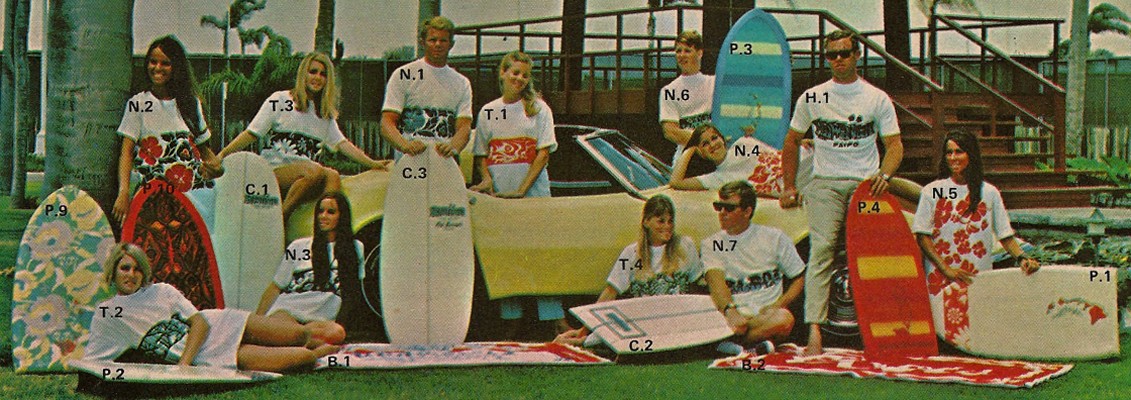
 |
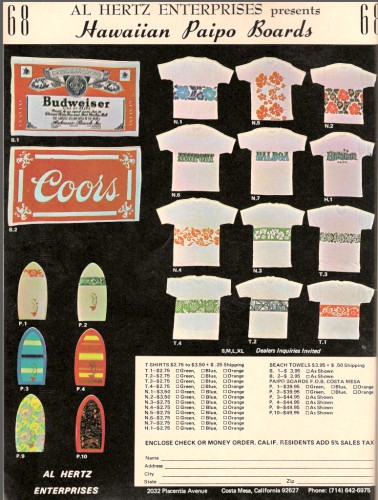 Al Hertz Enterprises Surfer June-July, 1968, Volume 9 Number 3 page 44. |
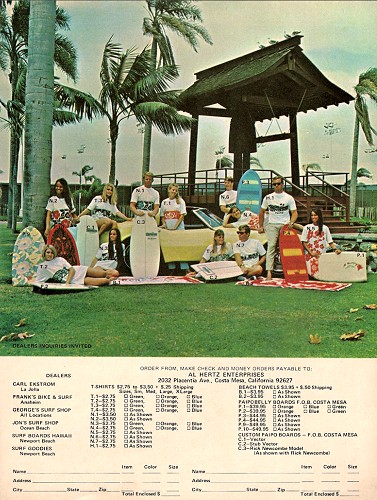 Al Hertz Enterprises Surfer August-September,1968, Volume 9 Number 4 page 99. |
| home | catalogue | history | references | appendix |
1769
Joseph Banks
and James Cook observe body and prone board surfing on the
west coast of Tahiti.
1779
James King and
David Samwell report prone board surfing by both genders in
the Hawaiian Islands.
1788
William Bligh
and James Morrison report prone surfing in Tahiti in extreme
swell conditions.
Morrison also
provides the first account of standup surfing and identifies
Iddeah, the wife of a local chief, as the most skilled.
1821
Captain Raine
observes descendants of Bounty mutineers riding prone boards
with “a ridge like a keel” on the bottom at Pitcairn Island.
1840, and
following
Illustrations
of Hawaiian surfing show a variety of riding positions
including prone, sitting, kneeling, drop-knee and standing.
Circa 1860
Percy Smith
notes the use of prone boards by New Zealand’s Maoris.
1860 (?)
Prone boards
first used in England.
1907
Small hand
boards in use at Manly Beach, Australia.
1915
After visiting
Hawaii, Jackson and Goldie ride prone boards at Point
Lonsdale, Victoria, and introduce local girl Grace
Smith-Wooton to the art.
1920s
Production
prone boards built by Risby Bros. in Tasmania.
1930s
Square nosed
timber boards with parallel rails, later known as Lamaroos (or
Looma-Roo), used in Victoria.
The design is
also common in New Zealand, South Africa and UK.
1932
Dr. Ernest
introduces his inflated rubber mat, the Surfoplane, in
Australia.
1934
Ronald Funnell
extols the virtues and dangers of prone surf-riding on narrow
solid wood boards to English readers in The Art of
Surf-riding.
1934, July
Plans for a
solid wood bellyboard published in Popular Mechanics magazine.
1935, August
Plans for a
laminated redwood-pine prone board printed in Popular Science
magazine.
1940-1945
Owen
Churchill's moulded rubber swim-fin design adopted by the US
Navy and issued to their Underwater Demolition Teams in the
early 1940s.
1946?
Vernont
Bartlet’s You and Your Surfboard, an introduction to prone
board surfing, published in Great Britain.
1953
Curved prone
boards in ash or chestnut and the Solarbo, an “extra buoyant
flat” balsa board, available in Newquay, England.
1955, December
Wally Froiseth
builds his first Hawaiian Pai Po Board, re-designed in early
1956 and followed by a patent application on May 9, 1956.
1958
In Sydney,
Leigh Tingle has a twin fin fibreglassed bellyboard built from
balsa off-cuts.
1959
George
Greenough builds his first balsa wood kneeboard.
Originally with
a conventional D fin, the following year he replaces it with
his first flexible high-aspect ratio fin.
1960
Bellyboards and
kneeboards manufactured in foam and fibreglass.
early 1960s
Jamie Farfor
observes Val Valentine building the dished-nose Paipo boards
with a wide-tailed plectrum-like template in Hawaii.
Farfor
purchases one of Valentine’s boards and, on returning to
Australia, manufactures his own model.
1962
George
Greenough builds his first balsa wood kneeboard with spooned
deck, initially with twin fins.
1964 (1965?)
Greenough
builds his first flexible Spoon and makes his first visit to
Australia.
1965
John Kelly
details the Skim board, a plectrum-shaped plywood finless
board accredited to John
Waidelich and
Jim Growney.
1965
Val Valentine
commercially produces Paipo Nui boards.
1966
“Still others
like a short bellyboard (sic) and a long ride like George
Greenough at Santa Barbara, California” – Bruce Brown in the
introduction to his The Endless Summer.
1966
Converse (USA)
release their rubberised canvas Hodgman model surfmat.
1967
San Diego’s
Steve Lis builds his first split-tail twin fin Fish kneeboard.
1967
The Coolite, a
molded polystyrene foam board, and the hollow molded plastic
Zippyboard introduced in Australia.
1967
Barracuda
Bellyboards - a twin fin plywood board designed by Sydney’s
Leigh Tingle.
1969
“Far-Out
flexible Surfboard - the wave of the future?” article on
Greenough’s Spoon printed in Popular Science magazine.
1969
Peter Crawford
shapes his first Slab (the name is credited to Midget
Farrelly), a wide bodied kneeboard at Wallace Surfboards as an
alternative to the low floatation Greenough Spoon.
1970
George
Greenough releases The Innermost Limits of Pure Fun.
1970
Shane
Surfboards (Australia) produce a foam kneeboard with a
Greenough influenced spooned deck, known as The Shoe.
1971
George
Greenough releases his short film on mat surfing, Rubber Duck
Riders.
1972
Tom Morey’s
Boogie Board released, originally offered as a buyer assembled
mail order product.
1972
Bahne screw and
pin fin box introduced and becomes a standard feature on most
kneeboards.
1974
Adoption of the
legrope (or surf-leash) sees standup surfers begin to appear
at extreme reef breaks, previously considered the domain of
belly and knee boarders.
1975
The
Bellybooger, a molded plastic twin fin bellyboard with spooned
deck, marketed in Australia.
1977
'Bout a
Spoonful article by Bob McTavish, eight easy steps to building
a Greenough Spoon, printed in Surfing World magazine.
1987
Boogie rider
Mike Stewart profiled in Surfer magazine.
1995
FCS fin plugs
1998
Endangered
Species, an article on kneeboarding, published in the Surfer’s
Journal.